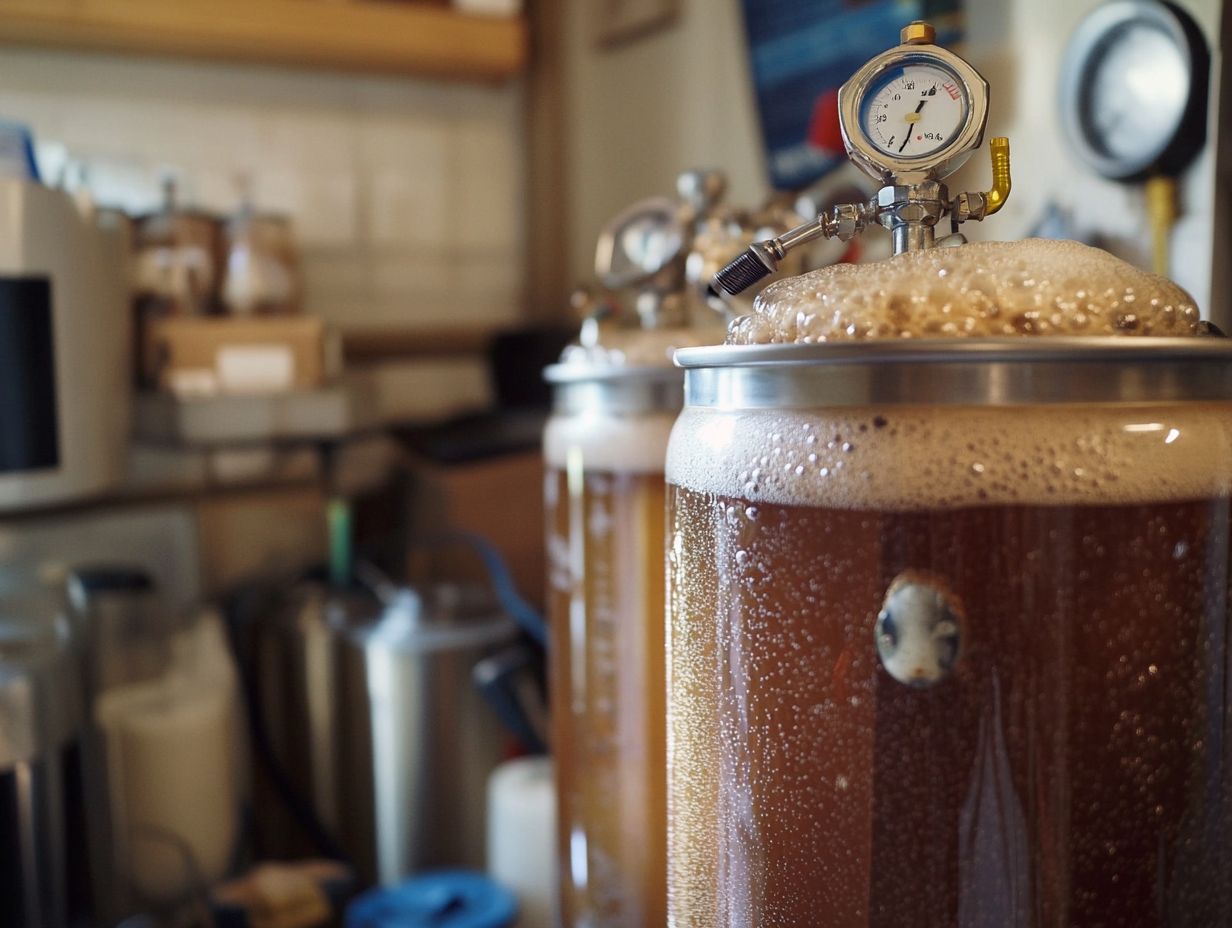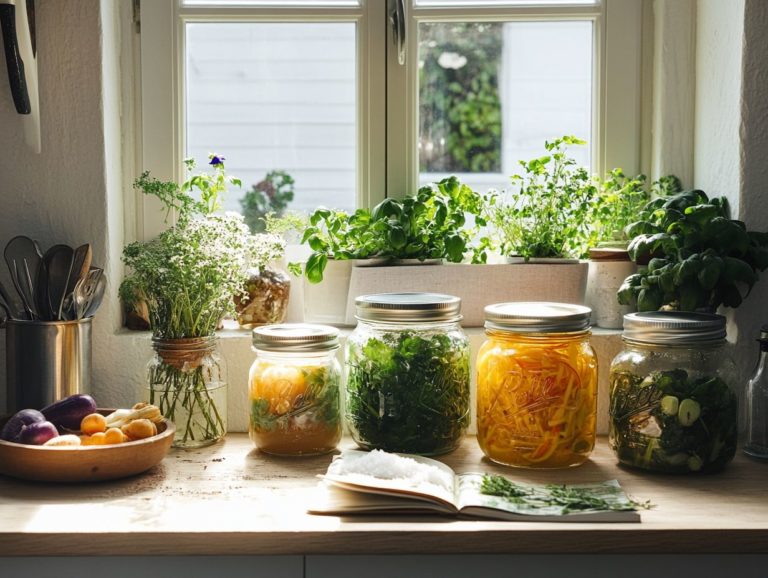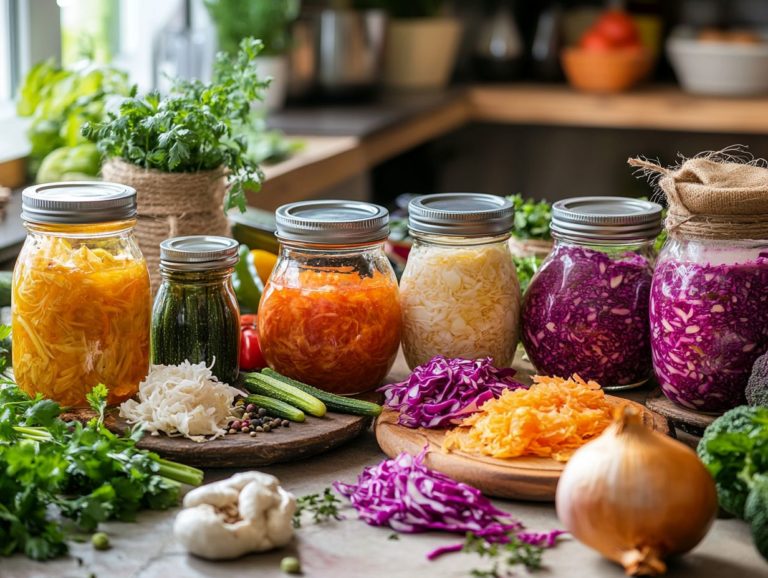5 Signs Your Beer is Fermenting Properly
Brewing beer is an art form intricately tied to the delicate fermentation process where the magic unfolds. Recognizing the signs that your beer is fermenting properly can be the defining factor between a glorious brew and a lackluster batch. This includes carefully monitoring the primary fermentor and identifying signs of fermentation, such as bubbling in the airlock.
This article delves into five key indicators of successful fermentation, from the bubbling in your airlock to the captivating transformation of color and aroma. It also touches on essential ingredients like brewing yeast, the various stages of brewing, troubleshooting tips for fermentation problems, and common pitfalls to avoid, all designed to help you master this critical phase of brewing.
Get ready to embark on an exciting brewing adventure!
Bubbling in the airlock is a clear sign of active fermentation and indicates that your beer is on the right track. This activity is often seen in the primary fermentor of a brewing kit.
Contents
- Key Takeaways:
- 1. Bubbling in the Airlock
- 2. Formation of a Krausen
- 3. Change in Color
- 4. Aroma of Fermentation
- 5. Specific Gravity Readings
- What Is the Fermentation Process in Beer Making?
- Frequently Asked Questions About Homebrewing
- What are the signs that my beer is fermenting properly?
- How long does the fermentation process usually take?
- What happens if my beer is not fermenting properly?
- Can I tell if my beer is fermenting properly just by looking at it?
- Is it normal for there to be a smell during the fermentation process?
- What should I do if I see mold or other signs of contamination during fermentation?
Key Takeaways:

- Bubbling in the airlock indicates active fermentation.
- A thick, foamy Krausen layer shows healthy fermentation.
- A color change, usually darker, signals proper fermentation.
- Monitoring sediment gives insights during fermentation.
1. Bubbling in the Airlock
Bubbling in the airlock is one of the most recognizable signs of fermentation. It clearly indicates that the yeast is transforming sugars into alcohol and carbon dioxide. This process is crucial in brewing beer, especially for beloved styles like Belgian ales and tripels.
Within the fermentation vessel, the yeast thrives under optimal conditions, ensuring your homebrewing adventure is a successful one. The rhythmic bubbles escaping the airlock serve as an important signal of fermentation’s progress, reflecting the yeast s metabolic activity.
As the yeast eagerly consumes the sugars, it releases carbon dioxide, which then pushes through the airlock, creating those characteristic bubbles you come to expect. Monitoring this bubbling activity is essential not just for confirming that fermentation is happening, but also for gauging its vigor.
If you notice that the bubbling slows down or stops prematurely, it could hint at potential issues that might affect your final product and may require fermentation troubleshooting.
Thus, careful observation enables you to intervene if necessary, ultimately enhancing the quality and success of your brewing process.
2. Formation of a Krausen
The formation of Krausen (the foamy layer that forms during fermentation) is a noteworthy indicator of fermentation, marked by a foamy layer atop the wort. This occurs as yeast rapidly multiplies and produces CO2 during the initial stages of fermentation, which is crucial for achieving that sought-after flavor profile in your beer, especially in a fermentation bucket.
This delightful frothy layer consists of proteins, hop residues, and yeast, each component playing a vital role in ensuring a healthy fermentation process. When you see krausen, it’s a clear sign that your yeast is hard at work, which is essential not just for creating alcohol but also for imparting those complex flavors and aromas that elevate your final brew, particularly in styles like Belgian tripel.
As a brewer, keeping an eye on the krausen during fermentation is important. Managing its size can help prevent blow-offs and maintain optimal yeast health. A gentle stir can distribute nutrients effectively, promoting a more consistent fermentation.
Adhering to proper temperature and sanitation practices guards against unwanted bacteria that could compromise the integrity of your beer, ensuring a smooth fermentation duration.
3. Change in Color
A noticeable change in color during fermentation can reveal intriguing stages of the brewing process. As the yeast works its magic on the wort, a captivating spectrum of hues emerges, reflecting the ingredients and techniques you’ve chosen, particularly in distinctive styles like Belgian ales and tripels.
Your selection of malts plays a pivotal role in determining the final color of your beer. Darker malts impart rich, deep shades, while lighter malts contribute those subtle golden tones that are so appealing. This is particularly noticeable in the brewing process from wort to final product.
The temperature during fermentation can influence the Maillard reaction, a captivating process that enhances both color and flavor complexity. For example, stouts might present a striking near-black appearance thanks to the roasted barley. Meanwhile, pale ales typically radiate with lighter amber hues.
These color variations do more than just please the eye; they also align with distinct flavor profiles, guiding you through a sensory journey that beautifully complements the visual allure of your brew. Utilizing different brewing techniques and taking specific gravity readings can help you better understand these transformations.
4. Aroma of Fermentation

The aroma of fermentation presents a complex bouquet that evolves as yeast metabolizes sugars into alcohol and various byproducts. This transformation provides you with essential cues about the fermentation process and the quality of the brewing ingredients, especially in the realm of homebrewing.
As fermentation unfolds, you’ll notice the initial scents of sweet maltiness and fruity esters blossoming, crafting an inviting and rich olfactory experience. However, it s important to remain vigilant.
Over time, those delightful aromas can shift. Fermentation monitoring and testing can help you catch these changes early.
While certain yeasts may gift you with pleasant floral notes, others might surprise you with off-putting odors that evoke memories of rotten eggs or vinegar, thanks to the development of undesirable byproducts. Being aware of these fermentation variables is key to producing a high-quality beer.
The interplay between the diverse aromas, the yeast strains you select, and the specific ingredients you use plays a crucial role in shaping the final flavor profile and overall appeal of your brew. Therefore, grasping these aromatic changes is vital for ensuring that you produce a high-quality product.
5. Specific Gravity Readings
Measuring specific gravity with a hydrometer, a tool used to measure the density of liquids, helping you determine sugar levels, is a critical technique in your brewing journey. It enables you to monitor fermentation progress, assess alcohol content, and troubleshoot potential issues by understanding the relationship between sugar levels and fermentation activity.
To achieve accurate specific gravity readings throughout fermentation, begin by sanitizing both your hydrometer and sampling vessel. This step is crucial to prevent any unwanted contamination. Taking readings at various stages enables you to observe changes, such as the gradual decline in sugar levels as yeast works its magic, converting sugars into alcohol and carbon dioxide.
You’ll likely notice this transformation visually, with bubbling or frothing as telltale signs of fermentation activity. When you see the specific gravity stabilizing over two consecutive days, celebrate! This means fermentation has wrapped up.
However, be mindful that low or stagnant readings might signal stalled fermentation, prompting you to investigate factors like temperature or yeast health. Regular monitoring not only paves the way for a successful brew but also equips you to make informed adjustments throughout the brewing process, ensuring proper fermentation completion.
What Is the Fermentation Process in Beer Making?
The fermentation process in beer making is where the magic happens. Here, yeast transforms the sugars from the wort into alcohol and carbon dioxide, fundamentally shaping the beer’s character and determining its flavor, aroma, and mouthfeel. It’s a critical aspect of the entire brewing experience, whether in homebrewing or commercial brewing.
This biological activity unfolds in several stages. It all begins with the lag phase, where the yeast acclimates to its new environment.
Then comes the exponential phase, during which the yeast reproduces rapidly and gobbles up sugar, usually in a fermentation vessel like a carboy or fermentation bucket.
As fermentation progresses, temperature becomes a key player. Warmer conditions typically encourage more vigorous fermentation, but if you’re not careful, you may encounter some off-flavors. On the flip side, cooler temperatures may slow things down, but they can lead to a much cleaner profile. Using a brewing kit with temperature control features can help manage this aspect effectively.
You ll find that different fermentation methods like primary versus secondary fermentation or open versus closed fermentation significantly influence the character of your final product. Many homebrewers love to experiment with these variables, tailoring their brews to reflect personal preferences and unique brewing styles.
What Are the Key Ingredients for Successful Fermentation?
Successful fermentation hinges on a delicate balance of key ingredients: high-quality yeast, fermentable sugars, and proper water chemistry. Together, these elements create the ideal environment for yeast to flourish, efficiently producing alcohol and CO2 in your homebrew.
Choosing the right type of yeast is pivotal for your brewing journey. Different strains possess varying characteristics and tolerances to alcohol, which can significantly influence both the flavor and the speed of fermentation.
The source of your fermentable sugars also plays a vital role; whether you opt for malted grains or fruits, each source imparts unique flavors that can dramatically affect the fermentation process. A good yeast starter can also help kickstart this process effectively.
Don t underestimate the importance of water quality; minerals and pH levels can either enhance or hinder yeast performance. Therefore, carefully choose your brewing ingredients based on what you want to achieve for successful fermentation and optimal results in your beverage production.
What Are the Different Stages of Fermentation?

The fermentation process involves several distinct stages that play a crucial role in crafting your beer. It begins with primary fermentation in a fermentation bucket or primary fermentor, where yeast works its magic by converting sugars. This is followed by secondary fermentation, which allows for conditioning and flavor development. Each of these stages contributes significantly to the overall profile of your brew, especially when brewing a complex style like a Belgian tripel.
During primary fermentation, which lasts from a few days to a couple of weeks, yeast cells flourish in a controlled environment. They convert simple sugars into alcohol and carbon dioxide (CO2), all while thriving at optimal temperatures between 65 F and 75 F. After this vigorous phase, your beer enters secondary fermentation, a vital step that can take anywhere from a week to several months, depending on the complexity you desire.
This phase allows undesirable byproducts to settle, resulting in a clearer brew, while flavors continue to deepen and mature. This settling often forms a layer of trub, the sediment formed during fermentation. Proper management of temperature and oxygen levels throughout these stages is essential for achieving a balanced and polished final product, reflecting your skill and intention as a brewer.
In conclusion, understanding the fermentation process is key in brewing. Unleash the full potential of your brew by experimenting with different techniques and ingredients, and enjoy the art of fermentation!
How Can You Tell If Your Beer Is Not Fermenting Properly?
To determine if your beer isn’t fermenting as it should, keep an eye out for key signs of fermentation. Look for the absence of bubbling in the airlock, a lack of krausen formation, or no change in specific gravity readings over time. These indicators could point to potential fermentation problems that need your attention.
Often, these problems may arise from factors such as poor yeast health, incorrect fermentation temperatures, or insufficient oxygenation of the wort before pitching the yeast. To troubleshoot effectively, start by assessing the viability of your yeast; using a yeast starter can help kickstart a more vigorous fermentation.
It’s crucial to maintain an optimal temperature range specific to your yeast strain too high or too low can stall or inhibit fermentation altogether. Regularly monitoring specific gravity with a hydrometer or refractometer will give you valuable insights into fermentation progress and is essential for determining when you’re ready to move on to the next steps in your brewing journey. Proper fermentation monitoring can make a significant difference in the quality of your final product.
What Are the Common Mistakes That Can Affect Fermentation?
Common mistakes that can impact fermentation include improper temperature control, inadequate sanitation practices, and neglecting to monitor specific gravity. Each of these oversights can lead to fermentation issues that compromise the quality of your beer. Effective fermentation troubleshooting involves addressing these problems promptly.
Failing to pay attention to these critical factors can result in off-flavors, stuck fermentation, or even contamination that ruins your brew. To improve your fermentation outcomes, maintaining temperature stability is essential consider employing a temperature-controlled chamber or water bath to keep your desired range intact. This is key to avoiding issues like over carbonation.
Sanitation should be meticulous; everything from your equipment to your bottles needs to be thoroughly cleaned to avoid unwanted surprises. Regularly checking specific gravity not only gives you insights into sugar depletion but also lets you know when fermentation is complete, ensuring timely bottling and minimizing risks.
Finally, ensuring proper aeration during the yeast pitch can significantly enhance yeast health and fermentation efficiency, setting the stage for a truly exceptional brew. This is particularly important in homebrewing where each step can greatly impact your homebrew.
How Can You Troubleshoot Fermentation Issues?
Troubleshooting fermentation issues calls for a systematic approach on your part. It’s essential to analyze key factors like temperature, yeast viability, and the conditions within your fermentation vessel. Don t overlook the importance of fermentation testing to identify and resolve problems efficiently, ultimately ensuring a successful brewing process.
Begin by regularly checking the fermentation temperature; remember that both excessively high and low temperatures can severely impact yeast activity and flavor development. Next, assess the health of your yeast through a well-prepared starter. This step offers valuable insight into its viability and can help kickstart fermentation when the need arises. This method is often used in various fermentation techniques.
Consider implementing techniques such as nutrient additions or oxygenation at critical points to enhance your yeast’s performance. By carefully observing these factors and employing a structured troubleshooting method, you can effectively tackle common fermentation challenges, leading to a consistently superior product. Understanding the impact of fermentation variables is crucial in this process.
Frequently Asked Questions About Homebrewing

What are the signs that my beer is fermenting properly?
Signs of fermentation include:
1. Bubbling in the airlock: This is the most reliable sign of fermentation as it indicates that the yeast is actively producing carbon dioxide.
2. Change in color: A darker color means fermentation is happening.
3. Formation of foam: Foam or “krausen” on top of your beer is a good sign that fermentation is happening. The foam is created by the release of carbon dioxide.
4. Sediment settling at the bottom: During fermentation, yeast and other particles settle at the bottom of your fermenter. This indicates that fermentation is occurring.
5. A decrease in specific gravity (a measure of sugar concentration): Using a hydrometer, a tool used to measure the sugar content in your beer, you can track the specific gravity. A decrease is a clear indication that the yeast is consuming the sugar and producing alcohol.
How long does the fermentation process usually take?
The duration of fermentation can vary depending on the type of beer and yeast strain used. On average, the primary fermentation process can take anywhere from 1-2 weeks.
What happens if my beer is not fermenting properly?
If your beer is not fermenting properly, it could be due to incorrect temperature, yeast strain, or sanitation issues. Troubleshooting is important to prevent off-flavors or contamination. Addressing signs of fermentation completion is crucial.
Can I tell if my beer is fermenting properly just by looking at it?
While there are visual cues that suggest fermentation, such as bubbling in the airlock or formation of foam, it is not always a reliable method. It is best to use a hydrometer to track the specific gravity and ensure proper fermentation.
Is it normal for there to be a smell during the fermentation process?
Yes, it is normal for there to be a strong smell during fermentation. This is a result of the yeast actively consuming the sugar and producing alcohol and other byproducts. Don’t worry! The smell will fade once fermentation wraps up.
What should I do if I see mold or other signs of contamination during fermentation?
If you notice mold or other signs of contamination during fermentation, it is important to discard the batch and thoroughly clean and sanitize all equipment. Contaminated beer can be harmful to consume and should be avoided. Using a brewing kit can help minimize these risks.






